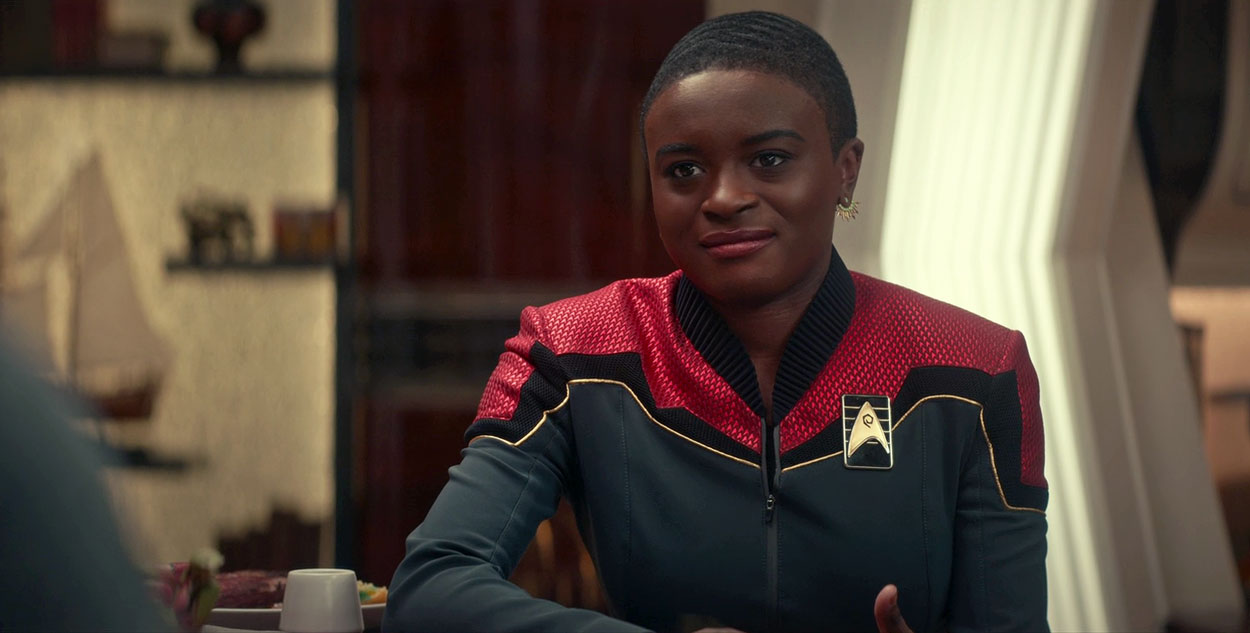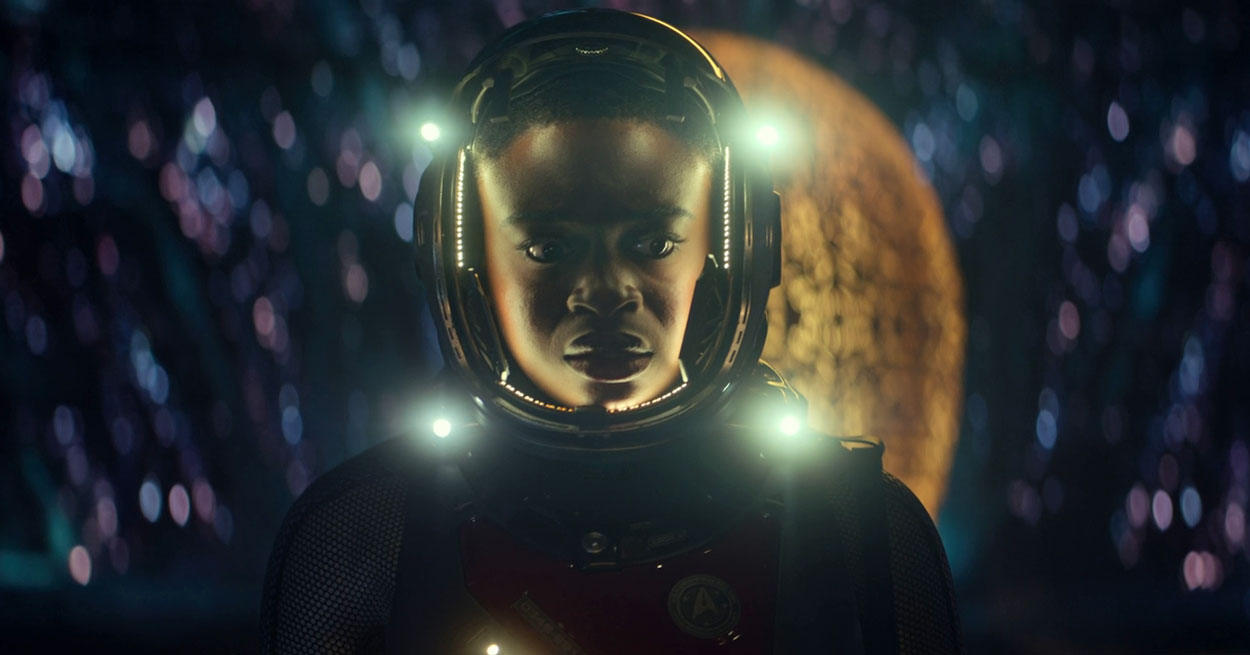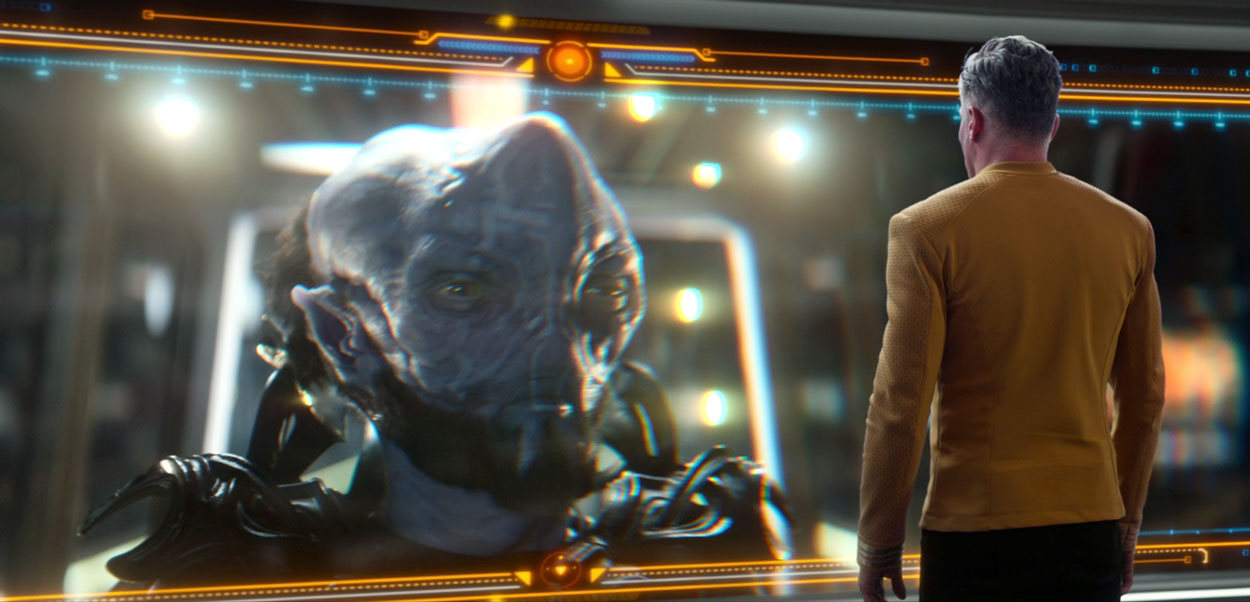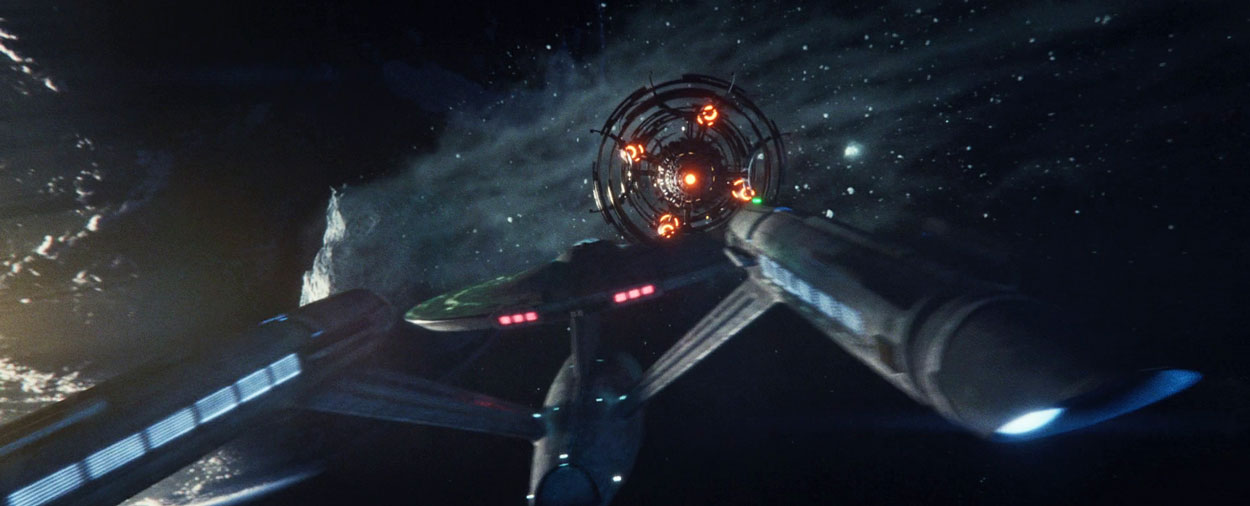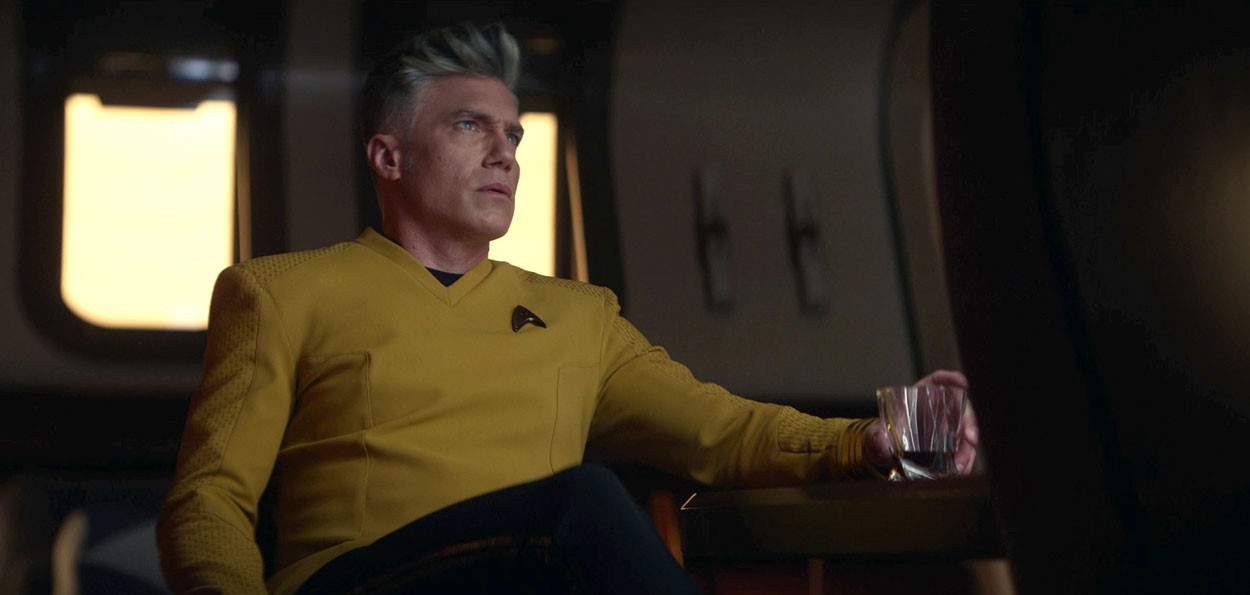This week’s Star Trek: Strange New Worlds adventure is an excellent story — but one that’s undercut by a rather pointless character decision. A mission to save a primitive world from disaster is another iconic Star Trek trope, and the charm of the episode is only increased by the incredible performance from the Enterprise’s youngest crewmate.
“Children of the Comet” also fully commits to this show’s idea of an ensemble cast, as we start with a nervous Uhura (Celia Rose Gooding) undergoing some good-natured hazing from Ortegas (Melissa Navia) — the helm officer’s insinuation that dress uniforms were expected for the evening’s events — an act that earns a friendly chuckle out of their commanding officer.
A dinner party in the captain’s quarters — one where Captain Pike (Anson Mount) himself serves as head chef — is a charming idea and a very Pike touch, something very much in line with the officer we got to know during his stint in Star Trek: Discovery Season 2. Inviting “regular people” to dine at the captain’s table is something that sets him apart from all the other Enterprise captains we’ve known over the decades; even Captain Sisko’s dinner invites never seemed to extend beyond family or his senior staff.
(And can anyone imagine Jim Kirk serving up ribs in his quarters? Doesn’t seem like his style.)
Even in this early outing, Celia Rose Gooding’s take on Uhura is shining, with their performance bringing both apprehension and earnestness which is a striking contract against the relaxed openness of the Enterprise crew. Her retort towards Spock (Ethan Peck) and Hemmer (Bruce Horak) when they try to wind her up — calling them out in their native languages — is snarky and fun in equal amounts.
New to the ship, Uhura is still on the edge of this family, something made clear when she isn’t quite in on the Spock-doesn’t-understand-human-humour gag and his confusion over one’s need to laugh when “a situation simply cannot get worse.” The light moment is undercut a little by Uhura’s own description of her past, and the reveal that she joined Starfleet after her parents and brother were killed in a shuttle accident.
The decision to write this permanently and horrifically-tragic backstory for Uhura really seems unnecessary to me; Uhura’s family don’t need to have died for her to be unsure about her place in the world, or to be indecisive about her ten-year plan. That’s a natural part of life, especially natural part of late adolescence, and the idea that such indecision should be spawned from trauma is not really great.
It’s easy enough to do the “running away to Starfleet” idea without basing it on another traumatic family past, especially that of a person of colour. Why add Uhura to a too-long list of black main characters — including Geordi La Forge, Worf, Travis Mayweather, Jake Sisko, and Michael Burnham — whose dead parents became central story points over the decades? (And that’s not even counting the Sarah Sisko situation, or Raffi Musiker’s estranged relationship with her son.)
The whole reveal seems to be based on the shock factor, and at the very least Anson Mount delivers a graceful reaction to the story — but it still didn’t sit well with me. I do like the concept that Uhura didn’t see herself as natural Starfleet material and the consequences of that. But did it need to be tied to a textbook tragic backstory? Absolutely not.
The plot of the episode is swung into motion when the crew finds out that the comet is currently on course to hit planet Persephone III and wipe out its inhabitants, the Deleb. After an initial attempt to move it using ion thrusters fails thanks to an unexpected force field, Pike sends a landing party — Uhura, Spock, La’an (Christina Chong), and Sam Kirk (Dan Jeannotte) — down to investigate.
Even here, Uhura’s apprehension of her place on the ship and her anxieties about her mission is clear. The little snippets of expression we see of her reacting to Nurse Chapel (Jess Bush) in the prep room, Chapel’s flirting towards Spock, or La’an’s prickly demeaner are stellar, and just build up marvelously to when the landing party beam down onto the comet, much to the Cadet’s amazement.
Uhura’s awe is matched by the go-getting nature of Sam Kirk, who manages to be both charming and supportive, especially as they begin exploring the inside of the structure on the comet’s surface. Sam is a nice character, even if his only purpose in this episode is to make a Yahtzee joke and then get electrocuted by the comet — a moment which definitely ups the stakes, despite the obviousness of it all.
Sam Kirk’s zapping traps the landing party on the comet, but also attracts the comets’ wardens — aliens dubbed the “Shepherds,” who arrive in a massive, ancient vessel which far outclasses the Enterprise in speed and weaponry. The Shepherds are “space warrior monks,” in Ortegas’ words, who believe their sacred duty is to protect the course of M’hanit — their name for the comet — and they see interference from the Enterprise as blasphemy.
The sequence between Pike and the Shepherd leader is a bit… dated. It fits very well into the various anti-religious themes of the Original Series (remembering, of course, that Gene Roddenberry once wrote a Star Trek film which had Kirk fighting Jesus). In the 21st century, however, the lack of nuance to it makes it all feel a little flat.
The Shepherd’s devotion to the M’hanit — and their belief that whatever it decides to do is the correct thing to do — is rather straightforward and is perhaps meant to be so. Their intransigence to the Enterprise’s mission is a clear frustration for Pike, especially when they warn him not to retrieve the landing party.
Down on the comet, Uhura is now — at least in La’an’s mind — the only person who can make sure they don’t get killed, and she’s having a hard time trying to decipher the patterns on the “shell” of the egg at the comet’s core. The juxtaposition of Spock’s terrible ‘pep talk’ and the more upfront, Nimoy-like Spock reassurance that follows is great — if just for the face Uhura pulls when his first words of support fall flat.
These versions of Spock and Uhura gel together very well, and even this early in their time together you can see how they’ll eventually become the upfront, respectful and honest friends down the road.
https://www.youtube.com/watch?v=3AjYy4vLTdg
ETHAN PECK: “She’s just, like, an incredibly impressive and talented person, which is an incredibly talented singer as well. So I just did my best kind of, like, sneak in behind her to beautiful singing.
I myself was a trained classical musician. I played cello growing up, so I’m not totally tone-deaf, I hope — but in terms of singing, yeah, I was quite nervous about We practiced quite a lot!”
Once the landing party discovers that the comet visual responds to music, things get spectacular as Uhura begins to communicate with it through harmonic changes and repeated music phrases. Gooding is the star of this show, and both other actors in the scene give her space to shine. The scene is perfectly scripted and shot, from the use of the Kikuyu song, to the reactions on Enterprise when they hear it, to the look on Spock’s face when Uhura asks him to sing along.
The big shame of it is that it doesn’t really go anywhere — the main comet crisis is still resolved by Spock’s ingenuity, as opposed to Uhura’s insight. Sure, her voice helps them get the shield down and beam back to the Enterprise, but it would have been interesting if Uhura’s linguistic — or should I say musical — breakthrough had been the key to re-directing the comet instead.
The landing party’s safe return does not please the Shepherds, who attack Enterprise. Ortegas’ spinning evasive sequence brings some fantastic visuals as the starship dodges torpedoes while returning fire, damaging the Shepherd’s vessel just long enough to allow Spock to develop a new plan.
Jumping into a shuttlecraft, the Vulcan plans to make the comet ’move itself,’ which apparently requires the Enterprise to go right through the jaws of the Shepherd’s powerful ship. The Enterprise’s dive past the enemy ship and into the comet’s tail is visually stunning, showcasing the scale of everything involved as the ship skips over the comet to park itself right in front of it, compelling the Shepherds to move Enterprise out of way.
This act of mercy is what Pike was counting on — a diversion to allow Spock to sneak a shuttlecraft out onto the comet’s surface undetected. Spock then uses the shuttle’s heat shields to warm up the ice of the comet, shearing off large chunks of rock and water vapor that alter its course enough to save Persephone III.
It’s a great moment, with the clichéd worry about the loss of Spock met relieved by the sound of Ethan Peck’s very Nimoy-like laugh on subspace radio. All the visuals of this episode, from the comet’s interior to the ships to Spock’s shuttle dancing across M’hanit’s surface, were stunning — while this is a 1960’s-era show in structure and vibe, we’re a long way from models on string and recoloured paintings of Earth — and it shows.
The redirection is a success, and the planet is saved – more so, as the sublimation Spock caused while fracturing the comet has dumped a huge amount of water onto Persephone III, which is sure to kick-start plant life (and civilization) on the planet. But before we can round off with a ‘mission’ accomplished (despite the Shepherd’s declaration of M’hanit’s life-giving power) we get an interesting coda from Uhura, who has decoded the messages from the comet.
Not only, it seems, did the comet know that its course was going to be corrected, it knew that Spock was going to melt it to change it’s course. The ‘mystical’ nature of the comet has Captain Pike dwelling on his own seemingly-preordained fate, and in a move inspired by M’hanit’s knowledge of its own destiny, he searches Federation records for names he knows only from his vision of the future…
…only to find that all the cadets he’s fated to save years from now really do exist.
CAMP NONSENSE OF THE WEEK
The week’s award must go to Spock’s terrible pep talk. Uhura is right, Lieutenant: don’t take your foot off the gas on that one — you’ll get it, eventually. (Maybe.)
OBSERVATION LOUNGE
- This episode takes place on Stardate 2912.4.
- The official designation for the comet is “C/2260-Quentin.”
- The Persephone system will later be visited by the Enterprise-D, as the ship picks up Admiral Mark Jameson and his wife from planet Persephone V in “Too Short a Season.”
- “I am familiar with Yahtzee, Lieutenant” got big laughs at the New York City series premiere screening in late April.
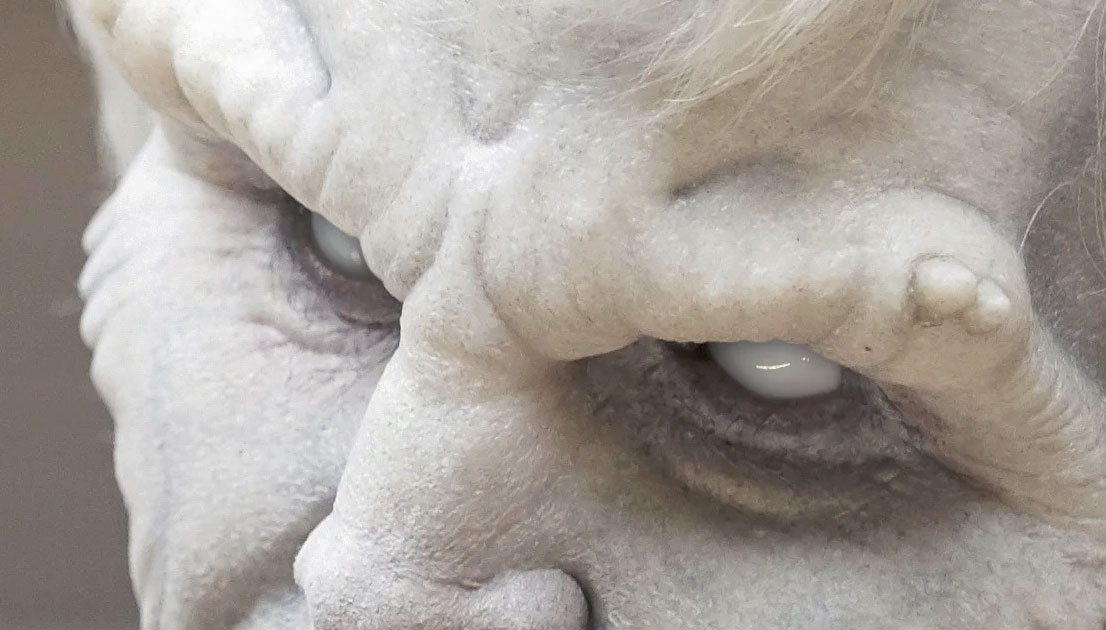
- Instead of using contact lenses, which could potentially damage actor Bruce Horak’s already-reduced vision, the Strange New Worlds post-production team uses VFX to modify his eyes to the milky white coloring of a blind Aenar.
- Tricorders have a built-in defibrillator function, which can provide a shock through the hand-held scanner as needed — a handy tool for dangerous away missions.
- While they fired blue in “Such Sweet Sorrow,” after two trips to Spacedock, the Enterprise phaser banks emit red-colored beams this episode — not inconsistent with the Original Series, which sometimes had the ship firing red phaser beams, too.
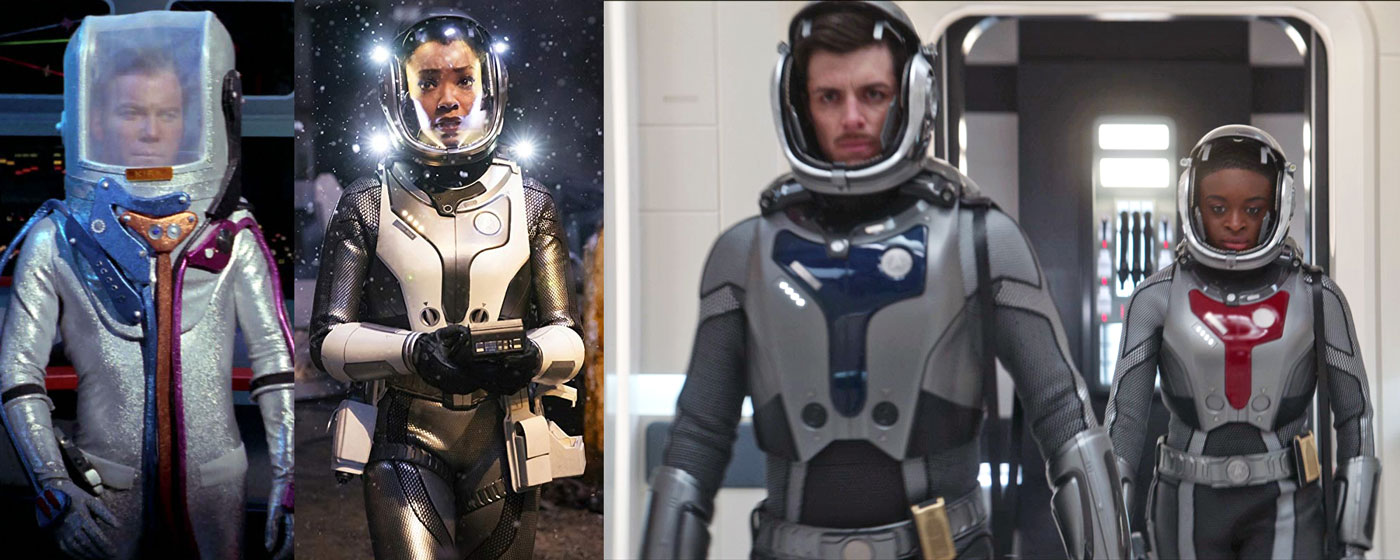
- Updated with departmental coloring, the Enterprise space suits are a revamp of the design introduced in Star Trek: Discovery — which themselves carry the central Y-shaped panel that evokes the shape of the under-helmet components on the classic “Tholian Web” suits.
- The cadets Pike seems destined to save are named Dusty Swender, T’quiel Dawn, Muliq Al Alcazar, Yuuto Hoshide, and Andrea Lopez, all of whom are around 9-10 years old at the time of this episode. (Let’s not ask how Federation privacy laws allow someone to look up photos and details of random kids without any kind of parental approval…)
- Muliq Al Alcazar lives on Tendara Colony, future birthplace of one Annika Hansen (aka Seven of Nine).

Overall, “Children of the Comet” is a great episode, and Celia Rose Gooding acts their heart out as Uhura, giving us the unsure, youthful side of the character in equal parts to the charm, and grace that Nichelle Nichols brought to the role. Her backstory still leaves a slightly off taste in my mouth, though; not enough to ruin my ability to enjoy the show, but enough to start questioning whether the writers thought about it that hard.
The show is using its ensemble cast well, with Ortegas and Una (Rebecca Romijn) each having fun character moments despite being background characters in this plot. Hemmer’s soft introduction successfully underlines his hyper-competent, blunt personality, while the show continues to hint at how Spock is both the same as and different from the officer who will serve under Captain Kirk.
I’m still a little apprehensive about the writer’s treatment of Pike — even with Una’s suggestion that his fate may not be as set in stone as he believes — they’re still leaning towards his disability as something to be treated as equivalent to death itself. Maybe Number’s One about changing your fate shows us something of the change in mentality we might see, but it’s too early to tell.
![]()
Star Trek: Strange New Worlds returns with “Ghosts of Illyria” on Thursday, May 19 on Paramount+ in the United States, Australia, Latin America, and the Nordics, as well as on CTV Sci Fi Channel in Canada.
The series will arrive to the UK and Ireland on Paramount+ on June 22; additional international distribution has not yet been announced.


